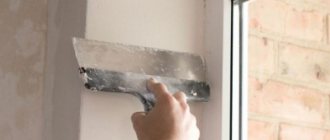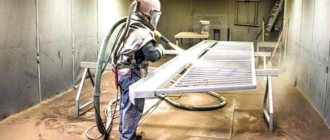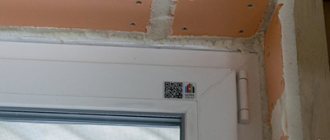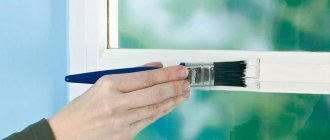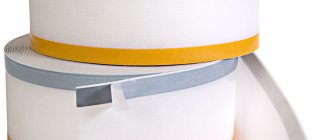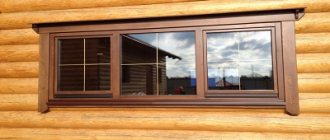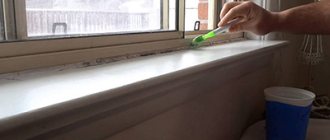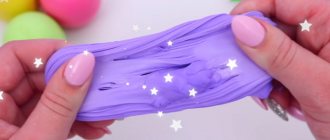Not every owner of an apartment or country house has the opportunity to purchase and install sealed double-glazed windows.
However, if the room has old wooden frames that have dried out over time, and the sashes cannot fit tightly to the profiles in the vestibules, this does not mean that you need to endure discomfort.
There are many ways to solve such problems using a special sealing compound - putty for wooden windows.
What it is?
Putty is a plastic substance made from mineral or synthetic components, designed to seal window structures and prevent the risk of them blowing out.
What is it used for?
The putty is used in any premises where wooden window structures are installed. The substance is used for the following purposes :
Fastening the glass in the frame if the glazing beads holding it have dried out and the product is not tightly fixed in the profile.- Filling cracks and crevices formed under the influence of an aggressive environment over time.
- Sealing of the opening frame in the vestibules for the winter period, to avoid the formation of a cold bridge.
Note. If there is no putty on old wooden windows, they rattle from strong winds, let in cold in winter, and also contribute to the formation of drafts due to the presence of cracks.
As a result of this, street dust may settle on the windowsill, and in the cold season, condensation or ice may form, which contributes to the formation of mold.
Putty is sold in most hardware stores in the country, and if it is unavailable or of poor quality, you can make a substance for sealing windows yourself.
Requirements
After applying the putty, it is necessary to wait some time for the composition to polymerize, after which it must meet the following requirements to ensure comfortable operation of the window structure:
- When applied, the substance must have sufficient plasticity to penetrate even small cracks, reliably blocking the access of air through these defects.
- The components included in the putty must ensure a high level of adhesion of the substance to the wooden structures of the window frame. When applying the paste, it should adhere tightly over the entire surface of the defect.
- Do not decrease in volume due to loss of moisture upon drying. After application into the crack, the putty should fill the entire volume provided to it.
- The composition of the plastic paste should not contain toxic substances that can adversely affect human health when evaporated.
- The composition of the putty should ensure rapid polymerization after application - no more than 15 - 30 minutes, depending on the components.
- In a frozen state, the material should not be destroyed by ultraviolet rays, rainwater or condensation.
- The material must withstand significant temperature changes and have the proper degree of frost resistance.
Important. In an ideal situation, re-treating cracks with a new portion of putty should be done no more than once a year.
During this period, the substance should not lose its physical and mechanical characteristics.
Why putty slopes
To achieve comfort in your home, it is not enough to install metal-plastic windows. An assembly seam is cut between the wall and the structure and blown in with construction foam. It holds the window, closes all the cracks, and prevents drafts from appearing in the house. Over time, it deteriorates under the influence of ultraviolet radiation, moisture, temperature changes, and loses its properties. To prevent this from happening, it is necessary to make slopes.
Previously, they were made from a mixture that was laid out in several layers on a rough coating, putty on top, plastered, and covered with paint. Now there are several options for window slopes - plastic, plasterboard, galvanized structures. Next, we’ll look at how to putty slopes on windows, what building material to choose, and the sequence of work.
Composition of window cleaner from the store
Ready-made window putty, which can be found on the shelves of specialized stores offering paints and adhesives, may consist of the following active components :
Acrylic is a synthetic polymer component based on polyacrylic acids.
The substance has a high level of adhesion to most surfaces and is widely used in the manufacture of high-quality paints and sealants for exterior or interior use.- Cyanoacrylate is an adhesive composition whose action is based on entering into a chemical reaction with the treated surface at the molecular level. It is characterized by an increased speed of setting and hardening.
- Butyl substances are used in the manufacture of window profiles. Sold in the form of a viscous paste, they seal well window structures made of any material, including wood.
- Rubber is a natural elastic material, environmentally friendly and hypoallergenic. Copes well with the task of sealing cracks in windows, quickly polymerizes, and is characterized by increased durability.
- Polyurethane is a synthetic substance that does not degrade when exposed to direct sunlight and withstands extreme temperatures.
- Silicone is a modern sealing substance that maintains an elastic consistency throughout its entire service life. Penetrates freely into every crack and has a high level of adhesion to all types of surfaces.
Any of the listed compositions is characterized by a high level of reliability and durability. The disadvantages include a high content of chemicals and an inflated cost, depending on the composition and brand under which the products are manufactured.
How to choose materials for interior and exterior work
The construction market provides a wide range of putties for finishing plasterboard and cement surfaces. There are two main types of mixtures - for interior and exterior work. Internal mixtures are designed to level surfaces. External ones are resistant to mechanical influences, for example, humidity, temperature changes. It is not recommended to use mixtures for interior finishing outside and vice versa.
There are also a number of universal compositions that can be used for external and internal finishing work, but professional builders do not recommend using these materials. They have a number of disadvantages: high price, questionable quality, toxicity.
For interior work, there are three main types of putty:
- starting - a light plastic mass used to level and strengthen the surface;
- finishing is distinguished by its white color, light structure, and is used at the final stage of surface coating;
- universal, which can be used at all stages of work.
How to cook it yourself?
Considering the low popularity of the factory product, it is supplied to many retail outlets in limited quantities and is not cheap. In this regard, there are many ways to prepare this product with your own hands based on natural and household ingredients that should be on hand in every home.
Drying oil and chalk
An effective, inexpensive solution for sealing cracks.
Ingredients (per 100 g of finished product):
- 20 g drying oil;
- 80 g of crushed chalk without polymer additives.
Recipe:
Chalk is mixed with drying oil, the finished solution is thoroughly mixed until a homogeneous viscous paste is achieved.
Reference. The material is easy to apply, can be painted, performs the function of sealing window structures, but quickly loses its performance when subjected to sudden temperature changes.
In the video you can see how to make putty from chalk and drying oil with your own hands:
Cement and vegetable oil
Hydraulic binder has increased moisture resistance and does not collapse under the influence of atmospheric moisture.
Ingredients (per 100 g of finished product):
- 20 g of vegetable oil sediment;
- 80 g of high-quality cement for facade decorative works.
Recipe:
- The material requires unrefined oil.
- The bottle of oil should sit without shaking until sediment forms.
- The liquid oil is drained. Only the sediment is used for putty.
- Cement is added to the oil, the material is mixed until the lumps are completely decomposed.
The resulting putty tolerates temperature changes, remains in a plastic state for a long time, and reliably protects the room from blowing and cold penetration.
Chalk and linseed oil
The substance obtained from these ingredients is in high demand not only among consumers, but also among professionals.
Ingredients (per 100 g of finished product):
- 25 g chalk;
- 75 g linseed oil.
Recipe:
- A piece of chalk is crushed in a pharmaceutical mortar or grated until it becomes powdery.
- The powder is filtered through a flour sifter.
- Particles remaining on the sieve are re-grinded.
- The ingredients are mixed until homogeneous.
- To test the finished product, you need to fashion a small ball. The consistency of the putty should resemble dough.
The advantage of this natural sealant is its natural yellowish tint, similar to natural wood.
Important. Has increased resistance to high and low temperatures.
Ash and tar
An old folk recipe that effectively helps solve the problem of defects on windows.
Ingredients (per 100 g of finished product):
- 120-150 g tar;
- wood ash - until the required consistency is achieved.
Recipe:
The tar is boiled in a saucepan over low heat for 1.5-2 hours.- Upon completion of the procedure, the liquid product should cool to room temperature - 18-20 oC.
- The ash must be crushed and sifted to a dust state, which should not contain large inclusions.
- Ash is added to the tar 1 tablespoon at a time and mixed until a paste is achieved.
The resulting putty has a high degree of polymerization, and therefore should be immediately used for its intended purpose.
Flour and sand
The composition is intended for emergency sealing of the window structure from the room side.
Ingredients (per 100 g of finished product):
- 35-40 g of fine sand without foreign impurities;
- 35-40 g of food flour (wheat, corn, rice);
- 35-40 g of clean water.
Recipe:
- The sand is carefully sifted on a fine sieve.
- The sifted sand is washed under port water and then dried.
- Flour is mixed with sand in dry form, the mixture is brought to a homogeneous state.
- Gradually, water is added 10-15 g at a time, and the composition is kneaded like dough. If necessary, the amount of water must be increased relative to the indicator indicated above.
Important. The use of such homemade putty for external work is not allowed due to its low resistance to atmospheric moisture.
Flax oil and limestone
A durable putty that reliably protects wooden frames and glass from wind and cold for several years without the need for replacement.
Ingredients (based on 800 g of finished product):
- 400 ml linseed oil;
- 400-500 g of limestone.
Recipe:
- The oil is divided into 2 glasses - 200 ml each.
One glass is heated in a water bath until the boiling point of water is reached.- The heated oil is poured into a suitable container, to which a glass of the same, but cold product is added.
- Limestone is crushed with a hammer or in a mortar and filtered through a sieve. You can immediately buy the powdered product.
- The powder is gradually mixed into the oil, 50 g at a time, until a paste-like structure is achieved.
Due to the peculiarities of preparation, the substance may turn out to be too much - from 800 g to 1 kg. However, the putty can be stored for a long time in a closed container at room temperature without loss of performance properties.
Talc and sunflower oil
Window putty based on these ingredients has increased resistance to moisture and can be used for outdoor use.
Ingredients (per 100 g of finished product):
- 20 g of vegetable oil sediment;
- 80 g talc.
Recipe:
- As a rule, talc is sold in the form of a fine powder and cannot be crushed.
- The oil is left to stand until a sediment forms, after which it is mixed with talc powder until a paste is achieved.
The putty must be quickly applied to the window, as it has a polymerization period of no more than 30 - 40 minutes. When hardened, it creates an elastic structure that is resistant to external influences.
Chalk, rosin, rendered lard
The substance is easy to produce, can be stored in the refrigerator for a long time, is easy to apply and does not decompose under the influence of ultraviolet radiation.
Ingredients (per 100 g of finished product):
- 9-10 g lard;
- 9-10 g rosin;
- 90 g chalk.
Recipe:
- Chalk and rosin are crushed in a mortar and filtered through a sieve.
- The lard is heated in a water bath until it reaches a liquid state.
- A mixture of chalk and rosin powders is added to melted hot lard.
- The substance is mixed until the consistency of sour cream is achieved.
Reference. The resulting substance has increased elastic properties and a water-repellent effect.
Other recipe options
In addition to the listed folk recipes for preparing putty for sealing window structures, there is also a multi-component mixture that is highly effective and will last for several years.
Ingredients (per 100 g of finished product):
- 12 g natural beeswax;
- 24 g linseed oil;
- 18 g student chalk;
- 34 g of white lead powder;
- 12 g natural ocher.
Recipe:
- The wax is grated and melted in a water bath.
- The chalk is crushed in a mortar and sifted.
- All components are thoroughly mixed until a homogeneous mass is achieved.
Putty made based on this recipe will last for several years without the need for restoration or repair work.
Required Tools
Sealing window structures is a simple procedure that can be performed by any adult with minimal experience working with a spatula or sealant. In order for the result to meet your expectations, you need to stock up on the following tools :
If you are caulking window structures using ready-made materials from the store, you will need a special gun for conveniently squeezing the mixture out of the factory container.- A knife or chisel to remove old substances and clean the surface to be treated.
- A construction or household hair dryer to soften old putty before removal.
- Use fine-grit sandpaper or sandpaper to deep clean the wood before sealing.
- When using a homemade substance obtained based on one of the recipes listed above, it is worth purchasing a dispenser and using the same gun.
- To compact the substance after application, you need to buy a spatula with a rubber working body.
- To push the substance into narrow crevices, you will need a set of small, sharp spatulas.
- After installing the putty, you should wash off the excess substance with a sponge dipped in a container of water.
A similar set of equipment can be sold in every hardware and construction store at a low cost, which makes it accessible to every average person.
Final putty before painting
The process of treating wooden surfaces with putty comes down to several steps:
- dilute the mixture until creamy, whipping with a drill with an attachment;
- You shouldn’t mix a lot of putty at once, because... it can dry quickly;
- start treating pits and cracks, creating a layer of 2 mm;
- When you have laid the first layer and waited for it to dry, level it with sandpaper;
- repeat the application of putty, reducing the thickness of the mixture to 1.5 mm;
- cover the surface with soil.
Now your wooden product is completely ready for painting, for which it is better to take paint compositions with the same components that are present in the putty: acrylic paint, water-dispersed paint, oil paint, etc.
When working with putty on wood or other material, remember that indoor air humidity cannot be higher than 50, and outdoors cannot exceed 75%. The ideal temperature in the room for quick drying of the putty is 20-25 degrees.
Step-by-step application instructions
In order to correctly apply the putty, and, after hardening, it will serve for a long time, it is necessary to accurately follow the recommendations of professionals, in accordance with the algorithm proposed below.
Connection between frame and glass
It is from this stage of work that the process of sealing windows begins, during which the following steps must be taken sequentially :
- The surface to be treated must be cleaned of old paint, dust and dirt. If there is previously installed putty, the substance is removed and the wood is sanded.
- If necessary, old materials are heated with a hairdryer before removal.
- Before starting work, all bare wood areas are treated with a penetrating primer.
- If the glazing beads holding the glass to the frame have dried out over time, they need to be adjusted to the window structure with a hammer. When elements are physically worn out, they must be replaced.
- If store-bought putty is used, it can be applied using a gun.
- The homemade substance almost always has the consistency of plasticine. A small amount of material is separated from the total mass, from which a long and thin straw is rolled.
- The material is pressed into the gap with your fingers, after which it is pushed into it with spatulas.
Important. When most of the putty is between the bead and the glass, the excess substance is removed from the wood with a knife, and from the glass with a sponge.
Seam sealing and protection
This procedure almost completely repeats the previous algorithm with some distinctive features :
- To detect gaps in the frame, work should be carried out in the cold season, since cold will penetrate into places with defects.
- Before pressing the substance, it is necessary to clear the gap from dust and dirt and clean it with the edge of a knife.
- If the gap in the frame is less than 1 mm thick, before using the putty it should be slightly heated to soften it and penetrate deeper into the structure.
- The substance is applied to narrow cracks using a spatula, and to wide defects the putty is applied with preliminary rolling in the hands.
If the color of the sealant does not match the shade of the frame, after curing, the wooden profile can be painted along with the applied putty.
Secondary sealing
The application and compaction of putty is carried out in accordance with the same algorithm, but, before starting work, the old substance must be removed from the gap to increase efficiency. This procedure is carried out in several stages :
The master tries to remove the old substance with a knife.- If hard putty does not give in, you should use a hair dryer to soften it.
- After the substance has become plastic, it is easily separated from the wood.
- Before installing new material, the gap is cleaned with a knife, spatula and sandpaper.
Important. To ensure a tight connection, you need to make sure that no old material remains in the gap before applying putty.
Cosmetic repair of wooden windows
Elimination of local damage. For example, fungal damage to part of the window frame.
- identification of the damaged area. To do this, you can carry out a small test: with an awl you need to push through dilapidated or suspicious areas of the frame; if the tip easily falls through, then the wood is damaged;
- cutting off the unsuitable layer;
- the cleaned area is dried. To do this, you can use a hair dryer or a fan heater (be careful with glass, direct the air flow directly to the wood);
- applying wood hardener and preservative;
- applying putty. Layer thickness - according to the instructions. If you need to apply several layers, you need to wait until the first one dries well;
- window painting.
More details are in the photo.
Pros and cons of using
Putty for wooden windows performs an important function, but at the same time, this process has some negative consequences.
Finished product
Advantages:
- Balanced composition that is easy to apply.
- After polymerization, the putty will serve the period specified by the manufacturer.
- Reliable fastening of glass.
- Increased energy efficiency of the room is achieved.
- Long-term storage.
Flaws:
- Chemically synthesized ingredients contain toxic substances.
- Overpriced products from a factory manufacturer.
Homemade
Advantages:
- Natural, environmentally friendly composition.
- Easy to manufacture.
- Low cost of available ingredients.
Flaws:
- If errors are made during manufacturing, the putty quickly loses its performance properties.
- Extra labor costs during production.
- Some components do not respond well to sunlight and aggressive environmental conditions.
Proven steps
When making homemade putty, it is not forbidden to save a little. You will need knowledge of the recipe for the production of this type of finish, and you should also know its main qualitative characteristics.
- The material must have excellent adhesion to the surface to which it is applied.
- The building material must be plastic, stretch easily and not crack when stretched.
- It is desirable that the putty hardens quickly and does not leave bubbles or defects after drying.
- The mixture should react only slightly to temperature conditions and high humidity.
- The service life of the building material must be at least 1 year.
These characteristics should be used as a guide when choosing the most suitable homemade putty formulation.
Average prices
Ready-made putties for sealing windows can be purchased at retail outlets across the country at the following prices :
- A standard briquette of dry matter in soft packaging, which is diluted with water, is sold at a price of 15-150 rubles (140-400 g).
- The substance in the form of a ready-to-apply paste is available for sale for 50-400 rubles (for 800-1200 g).
To produce homemade products, you need to purchase ingredients that are sold in hardware or grocery stores:
- Natural drying oil – 120-350 rubles (100-250 g);
- White chalk – 100-120 rubles (1 package, 100 pieces);
- Flaxseed oil – 80-50 rubles (250-1000 ml);
- Vegetable oil – 70-100 rubles (500 ml);
- Flour – 50-75 rubles (1000 g);
- Birch tar – 40-150 rubles (40-80 ml);
- Dolomite limestone – 50-60 rubles (1000-3000 g);
- Unscented talc – 50-150 rubles (40-150 g);
- Rosin - 30-80 rubles (20-100 g).
Prices for ingredients are given for the most affordable economy class products from domestic manufacturers.
